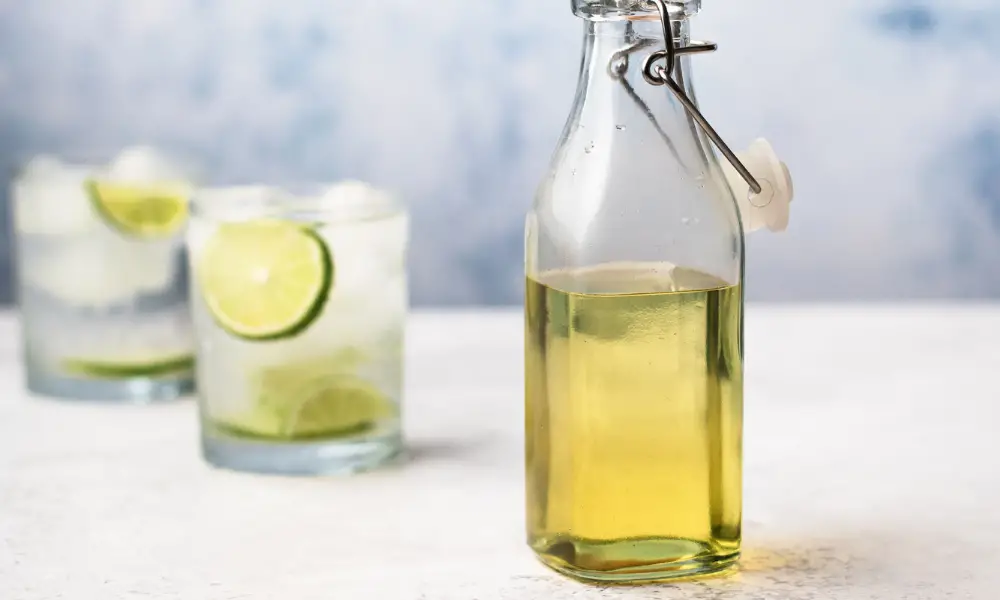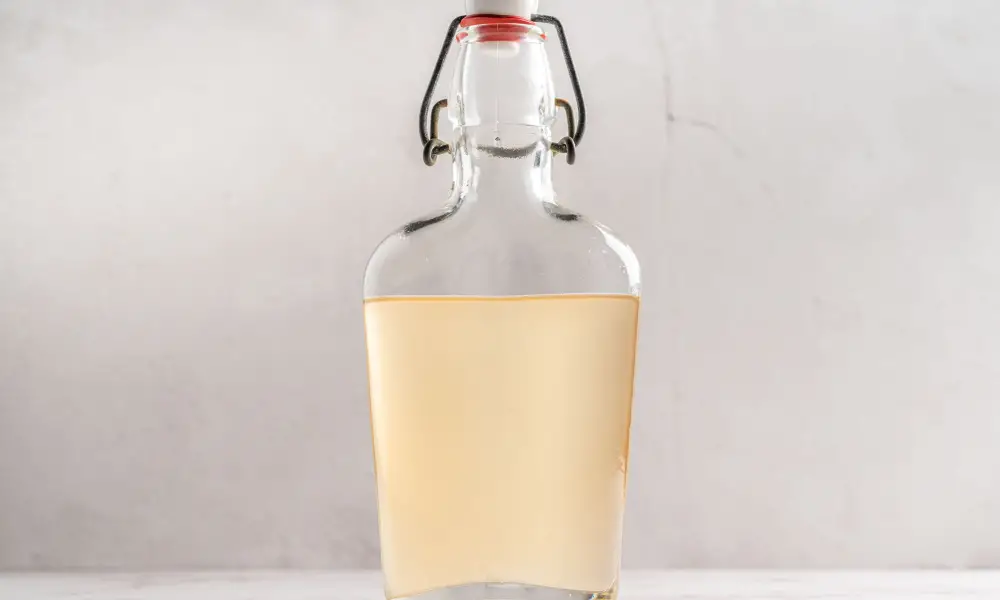If you’re making your simple syrup, you may wonder how to store it. It’s important to keep it in an airtight container and the refrigerator. It should keep for about a month. Adding additional ingredients will extend its shelf life to two to three weeks. If the syrup becomes cloudy, discard it. Vodka can help you store the syrup for even longer. The alcohol keeps bacteria at bay and prolongs its shelf life.
It’s a good idea always to have a batch of simple syrup on hand because it has many applications in various dishes. Learn proper storage techniques to keep simple syrup fresh for up to a month.

What is a Simple Syrup?
Simple syrup is a sweetener that can be easily made by mixing equal water and sugar. It typically appears in drink recipes for cocktails like the traditional Old Fashioned or Gimlet. While the sugar syrup is already a liquid and prevents your drinks from getting gritty, white sugar requires vigorous stirring or shaking to dissolve in cold beverages. Since simple syrup is so simple to produce, bartenders frequently create their own in big amounts so they can use it in their special cocktail recipes.
Simple syrup can sweeten ice cream, iced tea, sorbets, sponge cakes, and candied fruit. Other flavors may also be blended into it. Try adding vanilla beans, mint leaves, or cinnamon sticks to a basic simple syrup. Simple syrup produced at home should be kept in the fridge. It has a shelf life of up to one month when properly stored.
There are two primary types of simple syrup: rich syrup, which is more viscous and is created with twice as much sugar as water (2:1 ratio), and standard syrup, which is made with an equal amount of sugar and water (1:1). Everything can be weighed out by volume (for example, 1 cup sugar to 1 cup water), but if accuracy is important to you, weighing your water and sugar will produce results that are slightly more precise.
How to Store Simple Syrup
Preparing your container for long-term preservation is the main step in good simple syrup storage.
- Select an airtight container. Use a sealed glass jar, such as a Mason jar that you typically use for jellies or preserves, to store your simple syrup. Any airtight container will work, but some bartenders prefer glass because it won’t let other flavors bleed into your syrup.
- Thoroughly clean the container. Whatever the material, clean it well with hot water and dish soap or put it through the dishwasher to ensure the container is sterile. Before adding your prepared simple syrup, let it air-dry.
- Store the syrup mixture in the fridge. The amount of sugar in your combination and the cleanliness of the airtight container will determine how long your simple syrup will keep. A simple syrup made using the typical sugar-to-water ratio will be kept in the refrigerator for about a month.
How to Prepare Basic Syrup?
While providing a handmade substitute for corn syrup or the commercially available artificially flavored syrups, this complete procedure should only take around four minutes.
- Select the sugar of your choice. Because it has a neutral flavor, white sugar is typically used in simple syrup recipes, but brown sugar or demerara sugar also works.
- Decide on your sugar-to-water ratio. Rich simple syrup can be made by combining equal amounts of sugar and water (for instance, one cup of sugar and one cup of water). The amount can be scaled up or down, but the outcome depends on the sugar-to-water ratio. It will become slightly less dense and have fewer calories and carbohydrates if the sugar-to-water ratio is tilted in favor of water. You can increase the syrup’s sweetness by increasing the sugar content over the one-to-one ratio. More sugar means a longer shelf life because it serves as a preservative. That being said, if you consume too much sugar, you risk turning into jelly.
- Warm up your food. Over medium heat, add sugar and water to a small saucepan. Allow it to simmer for about two minutes, stirring regularly, or until the sugar dissolves. To dissolve the sugar, avoid boiling water because too much water may evaporate and change the correct sugar-to-water ratio. Allow the simple syrup to cool. Before storing the mixture, please remove it from the heat and let it cool to room temperature.
How to Spot Poor Simple Syrup?
Let’s start with a key point: it’s acceptable for the light syrup to turn yellow eventually. This doesn’t make it bad or ruin it.
Because of its eternal shelf life, syrup doesn’t go bad unless you want it to and fill the bottle with water and other pollutants.
If the syrup is properly stored and the bottle is intact, it is highly unlikely that the sweetener will go bad.
However, discard the container if you see any floating particles or a strange aroma after opening the bottle. The same is true if you notice a syrup defect.
As I’ve said in countless books, people are good at recognizing unhealthy food. Therefore, if your spider senses begin to tingle, trust them and toss the sweetener.
If Everything seems in order, taste the syrup to ensure it has enough flavor before using a substantial amount. If not, you must discard the syrup because it has beyond its expiration date.
How to Extend the Shelf Life of Simple Syrup?
Syrups are one area the simplest (and most affordable) methods for bartenders and cocktail connoisseurs to give each drink a unique touch. Syrups are merely simple—pun intended—combinations of sugar and water.
Simple syrup’s shelf life can be extended in two ways, according to Camper English of Alcademics: either by increasing the sugar to water ratio or by adding a neutral spirit.
It’s interesting how they differ. Simple syrup only lasts for about a month when the sugar to water ratio is 1:1. However, rich simple syrup, made by mixing equal parts sugar and water, will last for about six months before it turns cloudy.
Learning how to bottle in a vacuum may be the way you’d choose if you’d like to manufacture large amounts to utilize for months. After so according to Jennifer Colliau, owner and operator of Small Hand Foods, “bacteria can’t multiply without air.” “Bacteria can feed after you open a jar and expose the food to air.”
What are Different Forms of Simple Syrup?
Even though simple syrup only requires two ingredients, adding a different kind of sugar will change the finished product’s flavor, appearance, and consistency. Rich simple syrup, often known as Demerara syrup, is a form of simple syrup created from raw, light-brown sugar known as Demerara sugar. Because it has a fuller flavor than standard simple syrup, some people prefer it. But because of its brownish color, it will change the color of clear or light-colored beverages (such as vodka-based cocktails or milk steamers). Simple syrup can also be produced with brown sugar or turbinado sugar similarly.
Another type of simple syrup known as Gomme syrup or gum syrup is frequently used at more experimental bars in North America, coffee bars in Japan, and portions of Europe. (Gomme is the French word for gum.) Gum arabic, sap from a sub-Saharan tree that emulsifies the combination and permits a larger sugar-to-water ratio without crystallization, distinguishes it from conventional simple syrup (which would give the syrup a chunky or rough texture). Since Gomme syrup contains gum arabic, it also somewhat alters the texture of beverages in addition to adding sweetness. Gomme syrup’s consistency is frequently referred to as “smooth” or “silky.”
The basic form known as bar simple syrup, created without boiling the ingredients, is on the other extreme of the simple syrup continuum. Shake a bottle holding equal parts sugar and water until the sugar is completely dissolved to make it. This preparation technique is simple, but the syrup it produces is not as thick or tasty.
Another popular simple syrup variant in the culinary world is simple syrup gel, created by including pectin in the liquid. Both plain and flavored syrup gels are frequently used as the foundation for fruit sauces and preserves and as a garnish for fruits and baked products.
How to Buy Simple Syrup?
Here are some characteristics of a high-quality syrup to look for if you decide to purchase it (no judgment, no worries!) Look for a simple syrup made up only of water and sugar (or a variety of sugar).
Ingredients to Prevent Frequently:
Fillers and Preservatives: Many simple syrups sold in stores include additions like citric acid or other preservatives. Preservatives can change your syrup’s flavor while extending its shelf life. There are some methods for extending syrup’s shelf life without compromising flavor.
Some syrups also contain coloring for some reason that escapes me. For some people, the clear syrup might not look sufficiently “syrupy” (? ), but adding natural or artificial color is not essential for me.
High-fructose corn syrup (HFCS): Because HFCS is a fairly affordable sweetener, some less-priced simple syrups choose to utilize it. It does, alas, alter the flavor of the syrup and is frequently associated with overly sweet syrups. The danger is that your dishes won’t turn out properly if you use a simple syrup with HFCS as an ingredient.
Unfortunately, I’ve discovered that syrups that fit the requirements above are typically the most expensive.
So once more, if you can manufacture it yourself, that might be a better option. If not, try the advice above, and you should be good.
Conclusion
A glass jar with a tight seal is the best place to store simple syrup. This will keep it fresh for the longest time. Avoid using plastic containers as they are harder to sterilize and can harbor bacteria and germs. To sterilize your jar, use boiling water or hot soapy water to wipe it clean.
You can stabilize simple syrup by adding alcohol. The alcohol acts as a preservative and prolongs your finished syrup’s shelf life. The amount of alcohol should depend on how long you want your syrup to last. For recipes that require prolonged storage, you may need more alcohol.
